
Pest & Crop
Newsletter
Purdue Cooperative Extension Service

Purdue Cooperative Extension Service
Issue 15, July 7, 2017 • USDA-NIFA Extension IPM Grant
We have received multiple questions this past week about treating for western bean cutworm. The simple answer is, scout high-risk cornfields for egg masses and/or early larval damage and treat when over threshold. The timing of insecticide application is more important than product selection. Refer to last week’s Pest&Crop for scouting and threshold information. A listing of recommended insecticides can be found here: https://extension.entm.purdue.edu/publications/E-219/E-219.html.
The following video shows a dramatic contrast of two fields, both infested with western bean cutworm, but only one treated in a timely fashion:
| County | Cooperator | WBC Trapped | |||||
|---|---|---|---|---|---|---|---|
| Week 1 6/22/17 - 6/28/17 |
Week 2 |
||||||
| Adams | Kaminsky/New Era Ag | 0 | 6 | ||||
| Adams | Roe/Mercer Landmark | 0 | 8 | ||||
| Allen | Anderson/Syngenta Seed | 0 | 4 | ||||
| Allen | Gynn/Southwind Farms | 0 | 8 | ||||
| Allen | Kneubuhler/G&K Concepts/Harlan | 0 | 4 | ||||
| Allen | Kneubuhler/G&K Concepts/Koch | 0 | 10 | ||||
| Bartholomew | Bush/Pioneer Hybrids | 0 | 0 | ||||
| Clay | Bower/Ceres Solutions/Clay City | 0 | |||||
| Clay | Bower/Ceres Solutions/Brazil | 0 | |||||
| Clinton | Emanuel/Boone Co. CES | 1 | 1 | ||||
| Clinton | Foster/Purdue Entomology | 0 | 0 | ||||
| DeKalb | Hoffman/ATA Solutions | ||||||
| Dubois | Eck/Purdue CES | 0 | 1 | ||||
| Elkhart | Kauffman/Crop Tech Inc. | 35 | |||||
| Fayette | Schelle/Falmouth Farm Supply Inc. | 1 | 1 | ||||
| Fountain | Mroczkiewicz/Syngenta | 41 | 31 | ||||
| Fulton | Jenkins/N. Central Coop/Talma | 379 | 385 | ||||
| Fulton | Ranstead/N. Central Coop/Rochester | ||||||
| Gibson | Schmitz/Gibson Co. CES | 0 | 0 | ||||
| Hamilton | Campbell/Beck's Hybrids | 3 | 2 | ||||
| Hendricks | Nicholson/Nicholson Consulting | 0 | 1 | ||||
| Jasper | Overstreet/Purdue CES | 438 | 410 | ||||
| Jasper | Ritter/Brodbeck Seeds | 302 | 171 | ||||
| Jay | Boyer/Davis PAC | 5 | 1 | ||||
| Jay | Shrack/Ran Del Agri Services | 0 | 0 | ||||
| Jay | Temple/Jay County CES/Pennville | 0 | 1 | ||||
| Jay | Temple/Jay County CES/Redkey | 3 | 4 | ||||
| Jennings | Bauerle/SEPAC | 0 | 0 | ||||
| Knox | Bower/Ceres Solutions/Vincennes | 0 | |||||
| Knox | Bower/Ceres Solutions/Freelandville | 0 | |||||
| Kosciusko | Klotz/Etna Green | 75 | 112 | ||||
| Lake | Kleine/Kleine Farms | 0 | 4 | ||||
| Lake | Moyer/Dekalb Hybrids, Shelby | 157 | 108 | ||||
| Lake | Moyer/Dekalb Hybrids, Schneider | 246 | 151 | ||||
| LaPorte | Rocke/Agri-Mgmt Solutions, Wanatah | 120 | 122 | ||||
| LaPorte | Smith/Co-Alliance/LaPorte | 0 | 11 | ||||
| LaPorte | Smith/Co-Alliance/Fish Lake | 6 | 20 | ||||
| LaPorte | Smith/Co-Alliance/Union Mills | 15 | 19 | ||||
| LaPorte | Smith/Co-Alliance/LaCrosse | 35 | 149 | ||||
| Marshall | Harrell/Harrell Ag Services | 4 | |||||
| Marshall | Klotz/SR 10 & SR 331 | 29 | 81 | ||||
| Marshall | Miller/North Central Coop | ||||||
| Miami | Early/Pioneer Hybrids | 189 | 216 | ||||
| Newton | Moyer/Dekalb Hybrids, Lake Village | 16 | 139 | ||||
| Porter | Leuck/PPAC | 11 | 17 | ||||
| Polaski | Capouch/M&R Ag Services | 42 | 49 | ||||
| Polaski | Leman/North Central Coop | 4 | 22 | ||||
| Putnam | Nicholson/Nicholson Consulting | 0 | 2 | ||||
| Randolph | Boyer/DPAC | 2 | 2 | ||||
| Rush | Schelle/Falmouth Farm Supply Inc. | 0 | |||||
| Shelby | Fisher/Shelby Co. Co-Op | 0 | 0 | ||||
| Shelby | Simpson/Simpson Farms | 4 | 5 | ||||
| Shelby | Capouch/M&R Ag Services | 0 | 184 | ||||
| Starke | David Wickert/Wickert Consulting | 5 | 28 | ||||
| Starke | Larry Wickert/Wickert Consulting | 136 | 292 | ||||
| St. Joseph | Barry/Helena | 3 | 28 | ||||
| St. Joseph | Gary Battles | 1 | 12 | ||||
| St. Joseph | Carbiener/Union Twp. | 0 | 11 | ||||
| St. Joseph | Smith/Co-Alliance/Granger | 7 | 46 | ||||
| St. Joseph | Smith/Co-Alliance/New Carlisle | 0 | 3 | ||||
| Sullivan | Bower/Ceres Solutions/Farmersburg | 0 | |||||
| Tippecanoe | Bower/Ceres Solutions/Sullivan | 0 | |||||
| Tippecanoe | Bower/Ceres Solutions/Lafayette | 15 | |||||
| Tippecanoe | Nagel/Ceres Solutions | 1 | 1 | ||||
| Tippecanoe | Obermeyer/Purdue Entomology | 0 | 0 | ||||
| Tippecanoe | Westerfeld/Monsanto | 2 | 3 | ||||
| Tipton | Campbell/Beck's Hybrids | 0 | 2 | ||||
| Vermillion | Bower/Ceres Solutions/Clinton | 0 | |||||
| Wabash | Enyeart/North Central Coop | 1 | 10 | ||||
| Whitley | Richards/NEPAC | 23 | 70 | ||||
![]() epending on the year, Indiana's corn crop typically enters the critical flowering stages of pollen shed and silk emergence sometime between late June to late July. Success or failure during this period of the corn plant's life greatly influences the potential grain yield at harvest time.
epending on the year, Indiana's corn crop typically enters the critical flowering stages of pollen shed and silk emergence sometime between late June to late July. Success or failure during this period of the corn plant's life greatly influences the potential grain yield at harvest time.
As important as this process is to the determination of grain yield, it is surprising how little some folks know about the whole thing. Rather than leaving you to learn about such things "in the streets", I’ve developed this article and the accompanying one on silking (Nielsen, 2016) that describe the ins and outs of sex in the corn field.
Remember that corn has both male flowers and female flowers on the same plant (a flowering habit called monoecious for you trivia fans.) Interestingly, both flowers are initially bisexual (aka “perfect”), but during the course of development the female components (gynoecia) of the male flowers and the male components (stamens) of the female flowers abort, resulting in tassel (male) and ear (female) development.
Portions of the tassel may be visible before the plant technically reaches the last leaf stage (final visible leaf collar) has occurred. By definition, growth stage VT occurs when the last branch of the tassel emerges from the whorl (Abendroth et al., 2011). This authoritative source furthermore stated that growth stage VT is "initiated when the last branch of the tassel is completely visible and the silks have not yet emerged." Once upon a time, that exact developmental sequence may have been true, but today's hybrids tend to behave differently. It is not uncommon for silk emergence to begin not only prior to the last tassel branch appearing from the whorl, but also prior to the exsertion of anthers and pollen shed (Nielsen, 2009).
Plant height reaches its maximum at or shortly after growth stage VT as the final stalk internodes complete their elongation. The corn plant is most vulnerable to hail damage at growth stage VT because all of its leaves are exposed. Complete (100 %) leaf loss at growth stage VT will usually result in complete (100 %) yield loss by harvest. Even if pollination results in successful fertilization of the ovules, entire ear shoots will usually die because so few leaves remain to produce the necessary carbohydrates (by photosynthesis) to complete grain fill.
Approximately 1,000 individual spikelets form on each tassel and each one bears two florets encased in two large glumes. Each floret contains three anthers. An anther and its attached filament comprise the stamen of the male flower. The anthers are those "thingamajigs" that hang from the tassel during pollination. Under a magnifying lens, anthers look somewhat like the double barrel of a shotgun. Do the math and you will realize that an individual tassel produces approximately 6,000 pollen-bearing anthers, although hybrids can vary greatly for this number.
As these florets mature, elongation of the filaments helps exsert the anthers from the glumes. Pollen is dispersed through pores that open at the tips of the anthers. Pollen shed usually begins in the mid-portion of the central tassel spike and then progresses upward, downward and outward over time. Anthers typically emerge from the upper floret of the pair first, while those from lower floret typically emerge later the same day or on following days. Spent anthers eventually drop from the tassel and are sometimes mistaken for the pollen when observed on the leaves or ground.
The yellow or white “dust-like” pollen that falls from a tassel represents millions of individual, nearly microscopic, spherical, yellowish- or whitish translucent pollen grains. Estimates of the total number of pollen grains produced per tassel range from 2 to 25 million. Each pollen grain contains the male genetic material necessary for fertilizing the ovary of one potential kernel.
The outer membrane of a pollen grain is very thin. Once dispersed into the atmosphere, pollen grains remain viable for only a few minutes before they desiccate. Yet, with only a 15 mph wind, pollen grains can travel as far as 1/2 mile within those couple of minutes.
Therein lies the concern of the potential for pollen “drift” from a transgenic corn field to an adjacent non-transgenic corn field and the risk of transgenic “contamination” of grain intended for non-transgenic markets. The good news is that recent research suggests that the overwhelming majority of a corn field’s pollen load is shed in the field itself.
All of the pollen from a single anther may be released in as little as three minutes. All the anthers on an individual tassel may take as long as seven days to finish shedding pollen, although the greatest volume of pollen is typically shed during the second and third day of anther emergence. Because of natural field variability in plant development, a whole field may take as long as 14 days to complete pollen shed.
Peak pollen shed usually occurs in mid-morning. Some research indicates that pollen shed decreases after temperatures surpass 86F. A second “flush” of pollen often occurs in late afternoon or evening as temperatures cool. Pollen shed may occur throughout most of the day under relatively cool, cloudy conditions.
Weather conditions influence pollen shed. If the anthers are wet, the pores will not open and pollen will not be released. Thus, on an average Indiana summer morning following a heavy evening dew, pollen shed will not begin until the dew dries and the anther pores open. Similarly, pollen is not shed during rainy conditions. Cool, humid temperatures delay pollen shed, while hot, dry conditions hasten pollen shed.
Extreme heat stress (100F or greater) can kill corn pollen, but fortunately the plant avoids significant pollen loss by virtue of two developmental characteristics. First of all, corn pollen does not mature or shed all at once. Pollen maturity and shed occur over several days and up to two weeks. Therefore, a day or two of extreme heat usually does not affect the entire pollen supply. More importantly, the majority of daily pollen shed occurs in the morning hours when air temperature is much more moderate.

Full anther exsertion throughout all tassel branches.

Exserted anthers on a tassel.

Closeup of anthers.

Corn pollen size relative to a dime.
Abendroth, L.J., R.W Elmore, M.J. Boyer, and S.K. Marlay. 2011. Corn Growth and Development. Iowa State Univ. Extension Publication #PMR-1009. https://store.extension.iastate.edu/Product/Corn-Growth-and-Development [URL accessed July 2016].
Nielsen, RL (Bob). 2012. A Fast & Accurate Pregnancy Test for Corn. Corny News Network, Purdue Univ. [On-Line]. Available at http://www.kingcorn.org/news/timeless/EarShake.html [URL accessed July 2016].
Nielsen, RL (Bob). 2015. Unusually long silks in corn. Corny News Network, Purdue Univ. [online] http://www.kingcorn.org/news/timeless/LongSilks.html [URL accessed July 2016].
Nielsen, RL (Bob). 2016. Silk Emergence. Corny News Network Purdue Univ. [On-Line]. Available at http://www.kingcorn.org/news/timeless/Silks.html [URL accessed July 2016].
Russell, W.A. and A.R. Hallauer. 1980. Corn. (a chapter in Hybridization of Crop Plants. American Soc. of Agronomy-Crop Science Soc. of America. Madison, WI.
![]() he corn plant produces individual male and female flowers (a flowering habit called monoecious for you corny trivia fans.) Interestingly, both flowers are initially bisexual (aka “perfect”), but during the course of development the female components (gynoecia) of the male flowers and the male components (stamens) of the female flowers abort, resulting in tassel (male) and ear (female) development.
he corn plant produces individual male and female flowers (a flowering habit called monoecious for you corny trivia fans.) Interestingly, both flowers are initially bisexual (aka “perfect”), but during the course of development the female components (gynoecia) of the male flowers and the male components (stamens) of the female flowers abort, resulting in tassel (male) and ear (female) development.
The silks that emerge from the ear shoot are the functional stigmas of the female flowers of a corn plant. Each silk connects to an individual ovule (potential kernel). A given silk must be pollinated in order for the ovule to be fertilized and develop into a kernel. Up to 1000 ovules typically form per ear, even though we typically harvest only 400 to 600 actual kernels per ear.
Technically, growth stage R1 (Abendroth et al., 2011) for a given ear is defined when a single silk strand is visible from the tip of the husk. A field is defined as being at growth stage R1 when silks have emerged on at least 50 % of the plants. This whole field definition for growth stage R1 is synonymous with the term "mid-silk".
Silks begin to elongate from the ovules 10 to 14 days prior to growth stage R1 or approximately at the V12 leaf stage. Silk elongation begins first from the basal ovules of the cob, then proceeds sequentially up the ear. Because of this acropetal sequence of silk elongation, silks from the basal (butt) portion of the ear typically emerge first from the husk, while the tip silks generally emerge last. Complete silk emergence from an ear generally occurs within four to eight days after the first silks emerge from the husk leaves.
As silks first emerge from the husk, they lengthen as much as 1.5 inches per day for the first day or two, but gradually slow over the next several days. Silk elongation occurs by expansion of existing cells, so elongation rate slows as more and more cells reach maximum size. Elongation of an individual silk stops shortly after pollen is captured, germinates and then penetrates the silk.
If not pollinated, silk elongation stops about 10 days after silk emergence due to senescence of the silk tissue. Unusually long silks can be a diagnostic symptom that the ear was not successfully pollinated.
Silks remain receptive to pollen grain germination up to 10 days after silk emergence, but to an ever-decreasing degree. The majority of successful ovule fertilization occurs during the first 4 to 5 days after silk emergence (see photos that follow).
Natural senescence of silk tissue over time results in collapsed tissue that restricts continued growth of the pollen tube. Silk emergence usually occurs in close synchrony with pollen shed, so that duration of silk receptivity is normally not a concern. Failure of silks to emerge in the first place, however, does not bode well for successful pollination.
For those of you serious about semantics, let's review two definitions relevant to sex in the cornfield. Pollination is the act of transferring the pollen grains to the silks by wind or insects. Fertilization is the union of the male gametes from the pollen with the female gametes from the ovule. Technically, pollination is almost always successful (i.e., the pollen reaches the silks), but unsuccessful fertilization (i.e., pollen tube failure, silk failure, pollen death) will fail to result in a kernel.
Pollen grain germination occurs within minutes after a pollen grain lands on a receptive silk. A pollen tube, containing the male genetic material, develops and grows inside the silk, and fertilizes the ovule within 24 hours. Pollen grains can land and germinate anywhere along the length of an exposed receptive silk. Many pollen grains may germinate on a receptive silk, but typically only one will successfully fertilize the ovule.
Severe Drought Stress. The most common cause of incomplete silk emergence is severe drought stress. Silks have the greatest water content of any corn plant tissue and thus are most sensitive to moisture levels in the plant. Severe moisture deficits will slow silk elongation, causing a delay or failure of silks to emerge from the ear shoot. If the delay is long enough, pollen shed may be almost or completely finished before receptive silks are available; resulting in nearly blank or totally blank cobs. Severe drought stress accompanied by low relative humidity can also desiccate exposed silks and render them non-receptive to pollen germination.
The severity of drought stress required for significant silk emergence delay or desiccation can probably be characterized by severe leaf rolling that begins early in the morning and continues into the early evening hours. Such severe leaf rolling is often accompanied by a change in leaf color from “healthy” green to a grayish-tinged green that may eventually die and bleach to a straw color.
Silk Clipping by Insects. Although technically not described as silk emergence failure, severe silk clipping by insects such as corn rootworm beetle or Japanese beetle nonetheless can interfere with the success of pollination by decreasing or eliminating viable or receptive exposed silk tissue. Fortunately, unless the beetle activity is nonstop for days, continued elongation of silks from the husk will expose undamaged and receptive silk tissue at the rate of about one inch or more per day.
Silk "Balling". Occasionally, silks fail to emerge successfully because they fail to elongate in their usual straight "path" up the ear toward the end of the husk leaves. Instead, silk elongation becomes convoluted (twisted, coiled, scrambled) inside the husk leaves. This silk "balling" phenomenon is not well-understood and hybrids tend to vary in their vulnerability to this type of silk emergence failure. Two different pieces of circumstantial evidence are often associated with the problem. One is a physical restriction imposed on silk elongation caused by unusually"tight" or long husk leaves in certain hybrids. The other circumstance often correlated with silk "balling" is the occurrence of unusually cool nights during the time silk elongation is occurring, but prior to silk emergence. The physiological effect of such cool nights on silk elongation is not understood. It has been years since I last saw a field with a significant level of silk "balling" (Nielsen, 2000).

Silk elongation on the lower half of a V12 ear shoot; 10 to 14 days before silk emergence.

Silk elongation on the lower 2/3 of a V14 ear, about 4 days after V12; 6 to 10 days before silk emergence.
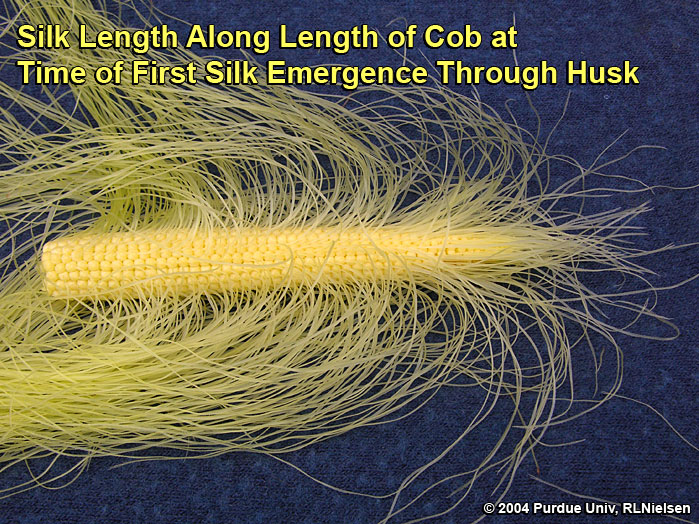
Variable silk length along length of cob at first silk emergence; illustrating the acropetal development of silks.
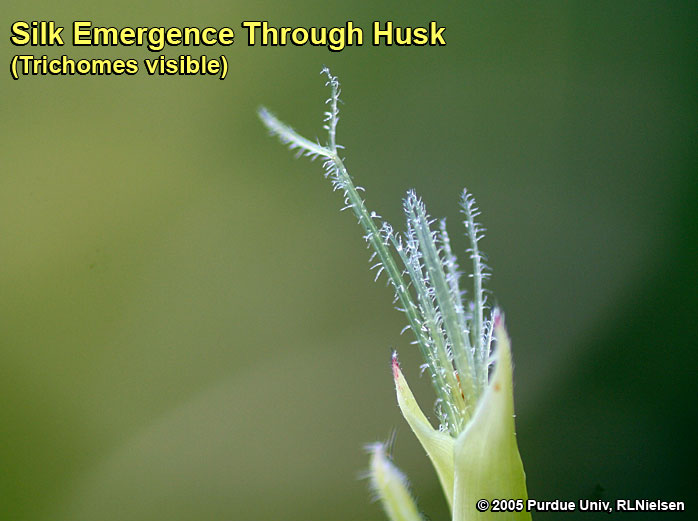
Trichomes visible on silks just emerging through husk leaves.

Pollen "captured" by silk trichomes on a popcorn hybrid with anthocyanin-pigmented silks.
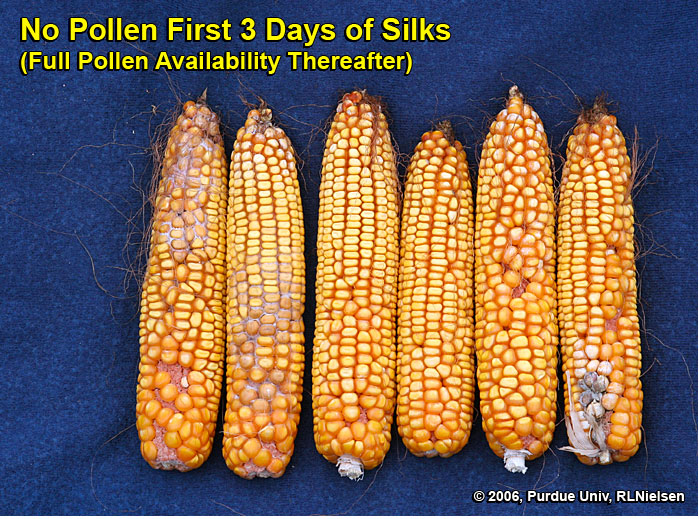
Kernel set on ears where pollination was prevented for 3 days after first silk emergence, then allowed to proceed without interference.
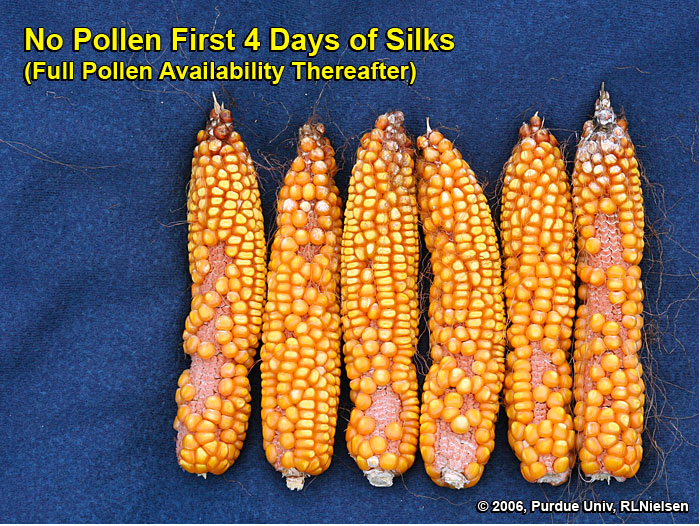
Kernel set on ears where pollination was prevented for 4 days after first silk emergence, then allowed to proceed without interference.
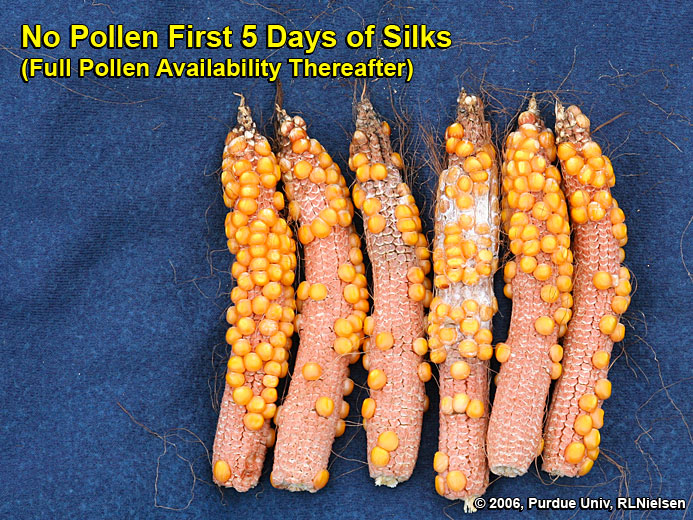
Kernel set on ears where pollination was prevented for 5 days after first silk emergence, then allowed to proceed without interference.
Abendroth, L.J., R.W Elmore, M.J. Boyer, and S.K. Marlay. 2011. Corn Growth and Development. Iowa State Univ. Extension Publication #PMR-1009. https://store.extension.iastate.edu/Product/Corn-Growth-and-Development [URL accessed July 2016].
Nielsen, RL (Bob). 2000. Scrambled Silks, Anyone?. Corny News Network, Purdue Extension. [online] http://www.kingcorn.org/news/articles.00/SilkBalling-0718.html [URL accessed July 2016].
Nielsen, R.L. (Bob). 2012. A Fast & Accurate Pregnancy Test for Corn. Corny News Network, Purdue Univ. [On-Line]. Available at http://www.kingcorn.org/news/timeless/EarShake.html [URL accessed July 2016].
Nielsen, R.L. (Bob). 2016. Tassel Emergence & Pollen Shed. Corny News Network, Purdue Univ. [On-Line]. Available at http://www.kingcorn.org/news/timeless/Tassels.html [URL accessed July 2016].
Purdue Univ. 2014. Corn Rootworms. Entomology Dept, Purdue Univ. [online] http://extension.entm.purdue.edu/fieldcropsipm/insects/corn-rootworms.php [URL accessed July 2016].
Russell, W.A. and A.R. Hallauer. 1980. Corn. (a chapter in) Hybridization of Crop Plants. American Soc. of Agronomy-Crop Science Soc. of America. Madison, WI.
Purdue Extension Entomology
901 W. State Street
West Lafayette, IN, 47907
(765) 494-8761
luck@purdue.edu
@PurdueExtEnt
PurdueEntomology
If you would like to be alerted by e-mail when the current issue of the Pest&Crop is available on-line, please enter your e-mail address and click the submit button.
It is the policy of the Purdue University Cooperative Extension Service that all persons have equal opportunity and access to its educational programs, services, activities, and facilities without regard to race, religion, color, sex, age, national origin or ancestry, marital status, parental status, sexual orientation, disability or status as a veteran. Purdue University is an Affirmative Action institution. This material may be available in alternative formats.